Summary
| PLAY | Granite Wash |
| SOUTH AUSTRALIA BASIN | Cooper |
| LOCATION | Moomba/Big Lake area, Nappamerri & Tenappera Troughs, Boxwood Depression |
| AGE | Early Permian (lowermost Patchawarra Formation/Tirrawarra Sandstone) |
| RESERVOIR | Big Lake Suite Granite Wash |
| SEAL | Patchawarra Fm. intraformational shales and coals |
| SOURCE ROCK | Patchawarra Fm. coals |
| HYDROCARBON PHASE | Gas |
| PRODUCTION | 54.64m3E6 (1.93Bcf) raw gas (at 31 December 2020) (PEPS South Australia) |
| HYDROCARBON FLOW RATES | “Proven sustained flow in multiple tests” (Ovenden, 2019); “commercial flow rates confirmed” (Moriarty et al, 2020) |
| POTENTIAL VOLUMES | Yet to be determined; >1 Tcfg? |
The Granite Wash play is defined by Santos (Ovenden, 2019 and Moriarty et al, 2020) as a resource within the Patchawarra Formation of the Permian Cooper Basin, located beneath the historical Toolachee-Daralingie production in the Moomba Field, South Australia.
The Cooper Basin is a Late Carboniferous to Triassic sedimentary basin, lying unconformably over early Paleozoic sediments of the Warburton Basin, which largely influenced the subsequent complex architecture.
The Granite Wash play occurs where granodiorites of the Big Lake Suite were intruded into the Warburton Basin during the early to middle Carboniferous. The granite was subsequently exposed at the surface following erosion during the Alice Springs Orogeny, a significant tectonic event that occurred in the Late Carboniferous, producing up to 8km of uplift in only a few million years (Meixner et al, 1999). The granite was reworked as a “wash”, intercalated with clastics of the Tirrawarra Sandstone and Patchawarra Formation, the latter acting as reservoirs, seals and major source rocks in the prolific Cooper Basin.
The "granite" core interval in the Moomba and Big Lake area generally consists of Granite Wash on top of in situ weathered granite above fresh granite of the Big Lake Suite.
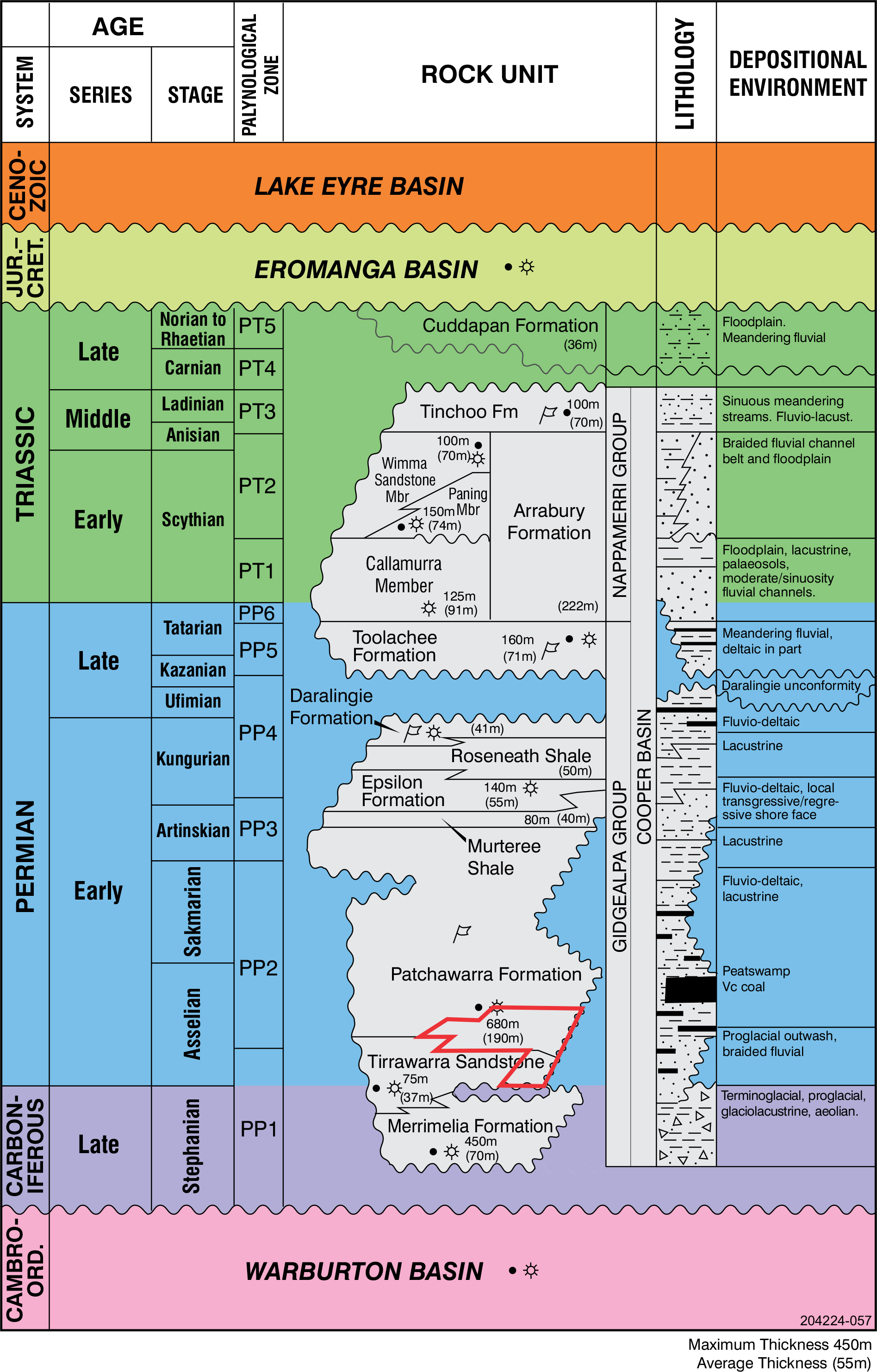
Geological summary of the Cooper Basin with location of Granite Wash play
The key petroleum events chart for the Cooper-Eromanga Basins shows that the critical moment was in the Late Cretaceous at the end of deposition of the Winton Formation, the last stage of the Eromanga Basin prior to uplift and erosion. Major generation from source rocks was occurring at this time, so formation of structures was critical.
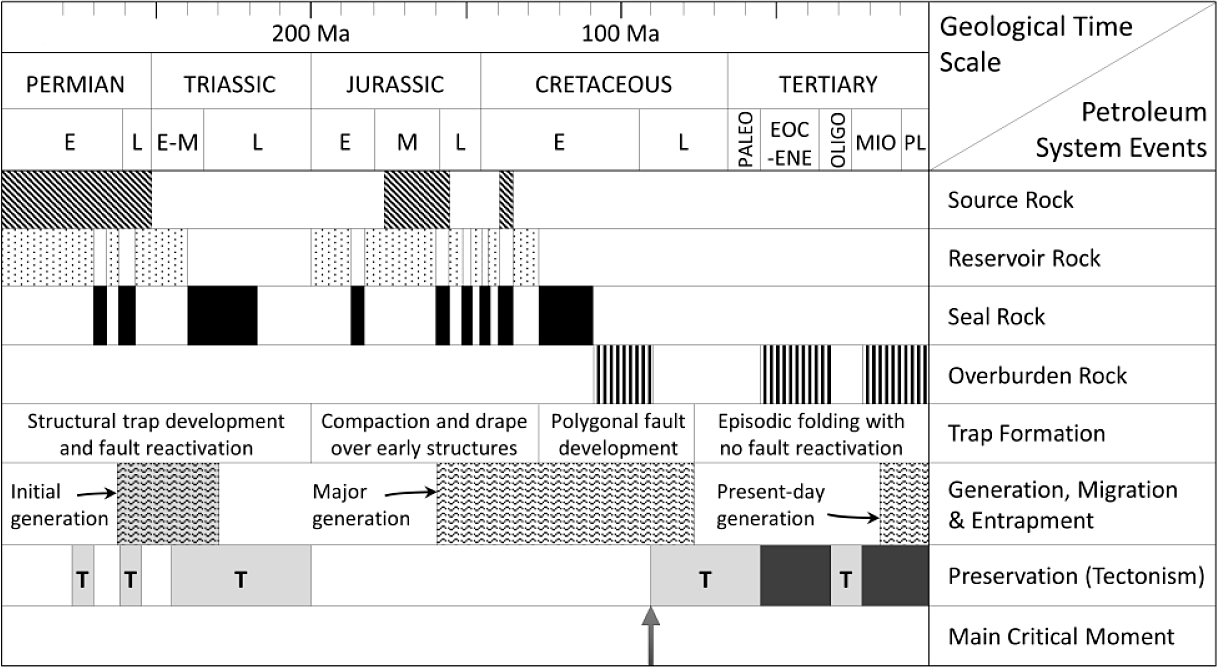
Key petroleum system events in the Cooper-Eromanga Basins petroleum systems (Borazani et al, 2019)
Gas shows in the Granite Wash have been known for many years, including a number of drill-stem tests (DSTs), although only with rates too small to measure (RTSTM) and no commercial flows had been achieved. Fracture stimulations were conducted over the granite Wash in Moomba 221 and 223 in 2018, and the results were the trigger for targeting the resource in the Santos drilling campaign in Moomba South in 2018-2019, which was primarily aimed at the Patchawarra Formation. All of wells Moomba 228 to 235 encountered the Granite Wash with gas shows, although with a range of thicknesses between 21m and 149m and varying reservoir quality. Santos followed this with 2 wells in 2019/2020 specifically designed to appraise the Granite Wash in Moomba South (Moriarty et al, 2020).
The Granite Wash play exists where the Warburton Basin underlies the Cooper Basin, with prospectivity for hydrocarbon accumulations occurring surrounding the sub-crop of the granodiorites of the Big Lake Suite below the Cooper Basin, primarily in the Moomba-Big Lake area and in the Nappamerri Trough.
Production from the Granite Wash play has been proven in the Moomba field; see PEPS South Australia for the latest open file production data.
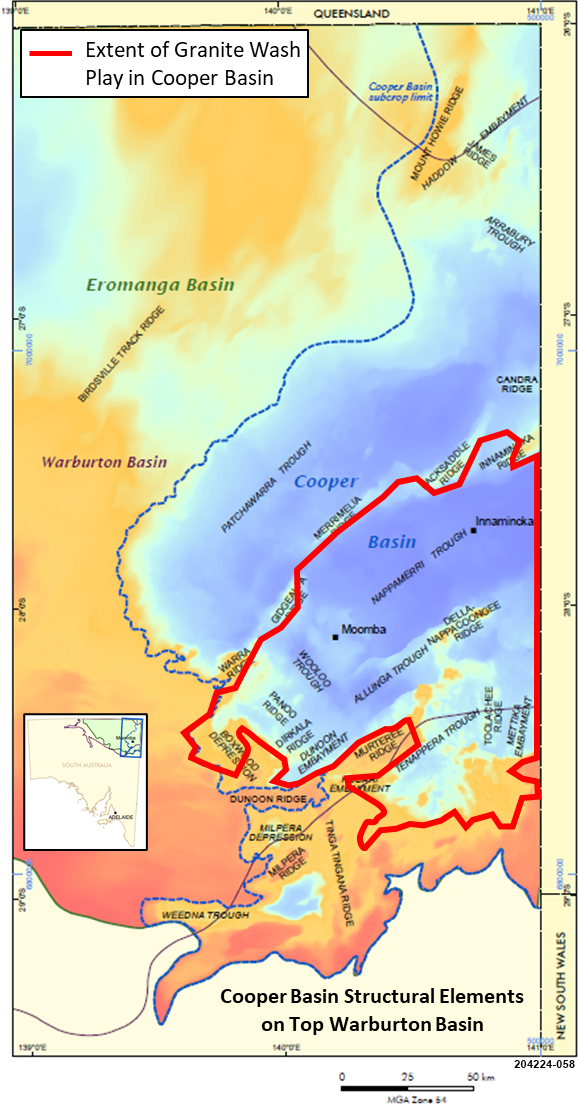
Extent of the Granite Wash play in the Cooper Basin

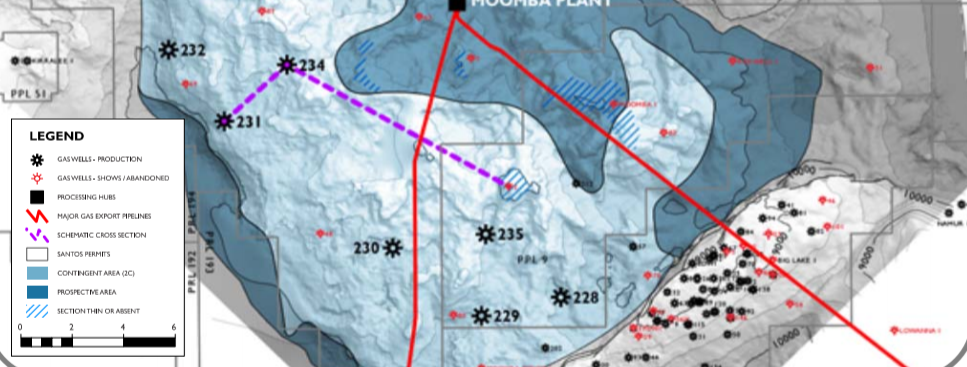
Schematic cross-section of the Granite Wash play in Moomba (Moriarty et al, 2020, and Ovenden, 2019)
Analogue: Outcrop analogue in SA: Reedy Creek Granite at Mannum Waterfalls (Lemon, pers. comm.)
International: Granite Ranges, Wyoming, USA
Moomba 234 (2019)
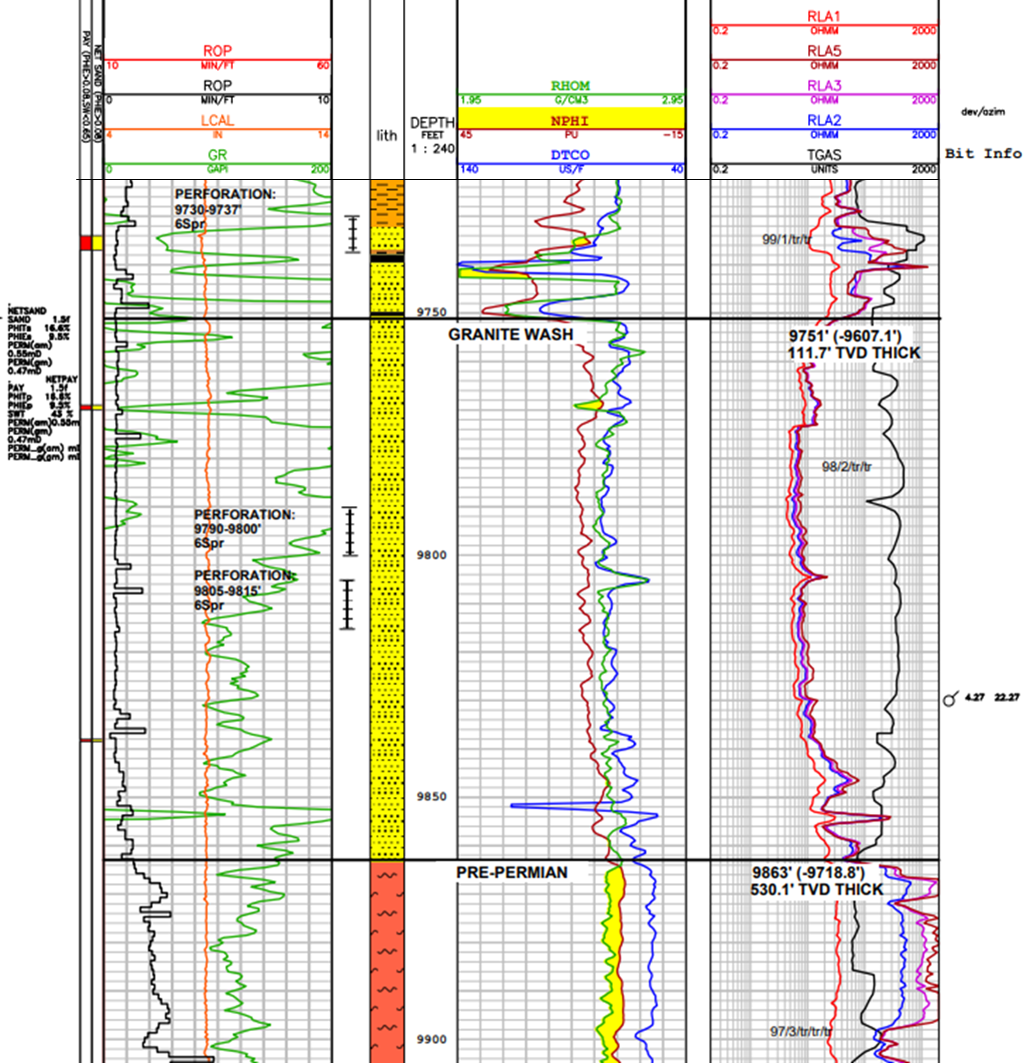
Granite Wash in Moomba 234 (excerpt from Composite Log)
Moomba 234 came online in March 2019 and had produced 3.60m3E6 (127mmcfg) from the Granite Wash as of 30 November 2020 (PEPS South Australia).
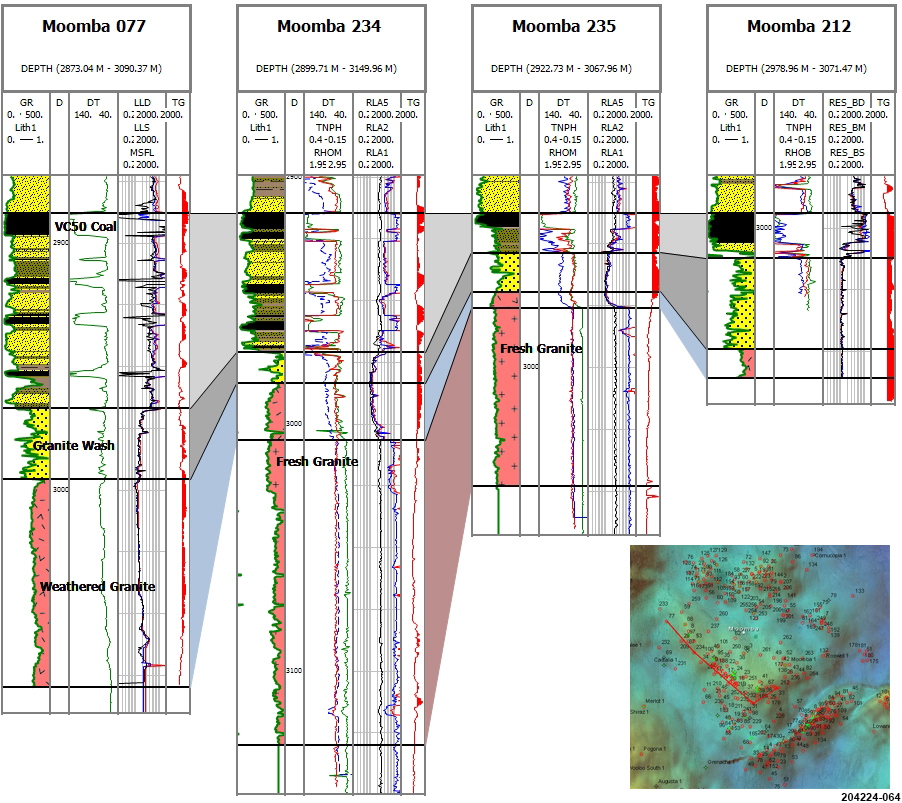
Moomba Field Granite Wash correlation; Datum: Top VC50 Coal
The Warburton Basin subcrop to the Cooper Basin consists in several places of weathered granodiorites of the Big Lake Suite. Significant erosion occurred following rapid uplift in the Late Carboniferous, whereupon the exposed areas of granite underwent a phase of alteration due to near-surface weathering processes. This weathering resulted in conversion of feldspars to clay minerals (predominantly illite) and creation of microporosity and microfracturing in the altered granite. Partial erosion and redeposition of granitic material resulted in the formation of an apron of “granite wash” alluvial fans on the flanks of Moomba South. This is interpreted to have occurred during the early Permian, with the Granite Wash often intercalated with typical clastic Patchawarra material (sandstone, shale, coal) in particular.
The "granite" core interval in the Moomba and Big Lake area generally consists of Granite Wash on top of in situ weathered granite above fresh granite of the Big Lake Suite. The mud log and downhole logs show gas in both the weathered granite and the wash.
Lemon (pers. comm.) described the Granite Wash as a mixture of mud, soil and large, angular fragments of fresh and altered feldspar, and is probably best described as a very immature sediment, a muddy granule conglomerate with very angular clasts. It is a bedded succession with well-defined bedding shown by silty layers and graded very coarse layers (silty-sandy at the base with granule tops). These beds are somewhat unusual in that they show coarsening upwards cycles. These are “sheet wash” deposits as soil and weathered granite was washed off the side of the Moomba granite hill. There are obvious fractures in the weathered granite that are both open and filled. The filling includes alteration products, illite and silica cement as plagioclase alters to illite and silica, especially in the presence of carbon dioxide.
The granites themselves are of varying nature, adding to the complexity of the Granite Wash play. Gatehouse et al (1995) reported that the granite in Big Lake 1 is coarse-grained and moderately weathered, consisting of abundant quartz (~40%) in aggregates up to 10 mm diameter, microcline, orthoclase and sericite, with common kaolinite, and trace amounts of fluorite and opaques. At Moomba 1 the granite is also very coarse grained but is predominantly orthoclase (~60%), quartz (~30%), plagioclase (5-10%) and chloritised biotite (5%).
Matrix porosity and permeability occur within the Wash, although this is highly variable in quality and distribution due to the weathered and reworked nature of the granite, and may be multi-tiered. Consequently, fracture stimulation assists with production allowing gas to flow at commercial rates (Moriarty et al, 2020).
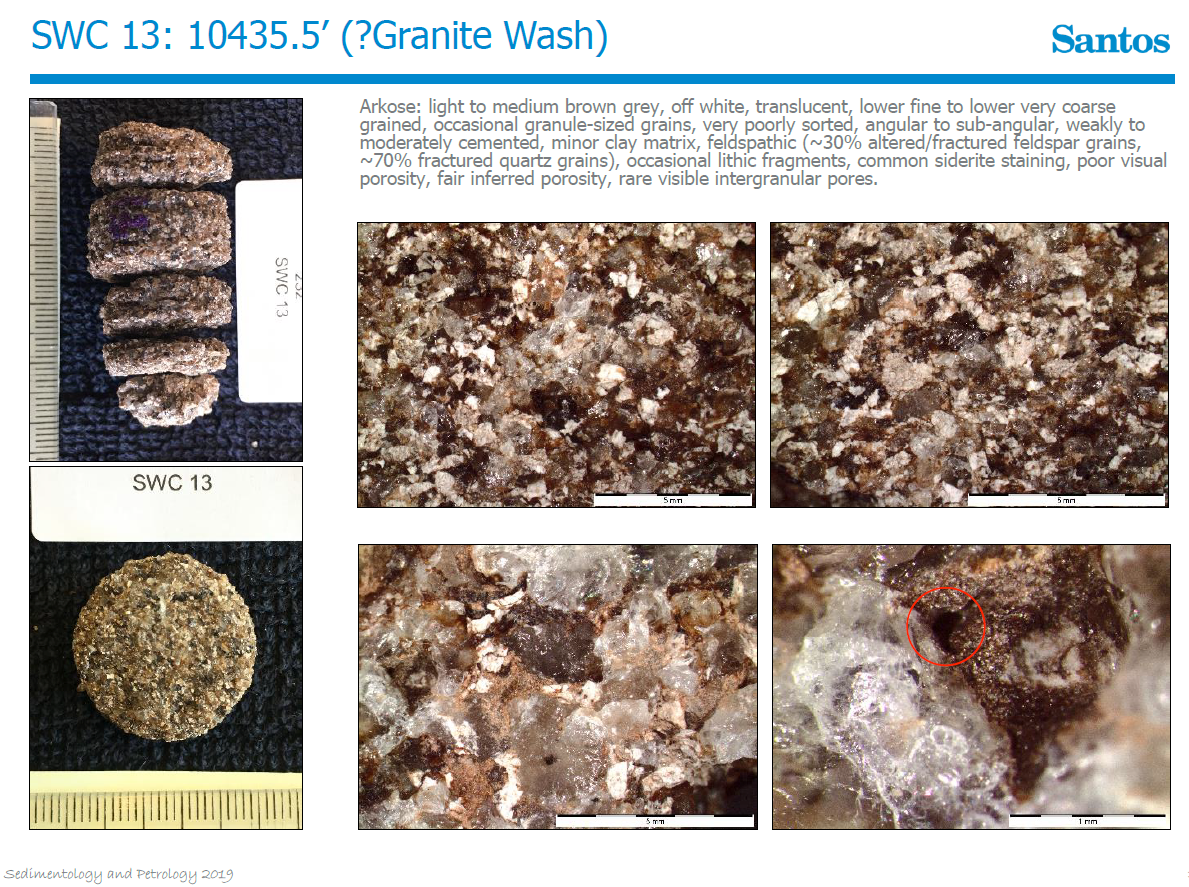
Sidewall core in the Granite Wash in Moomba 232 (from Well Completion Report)
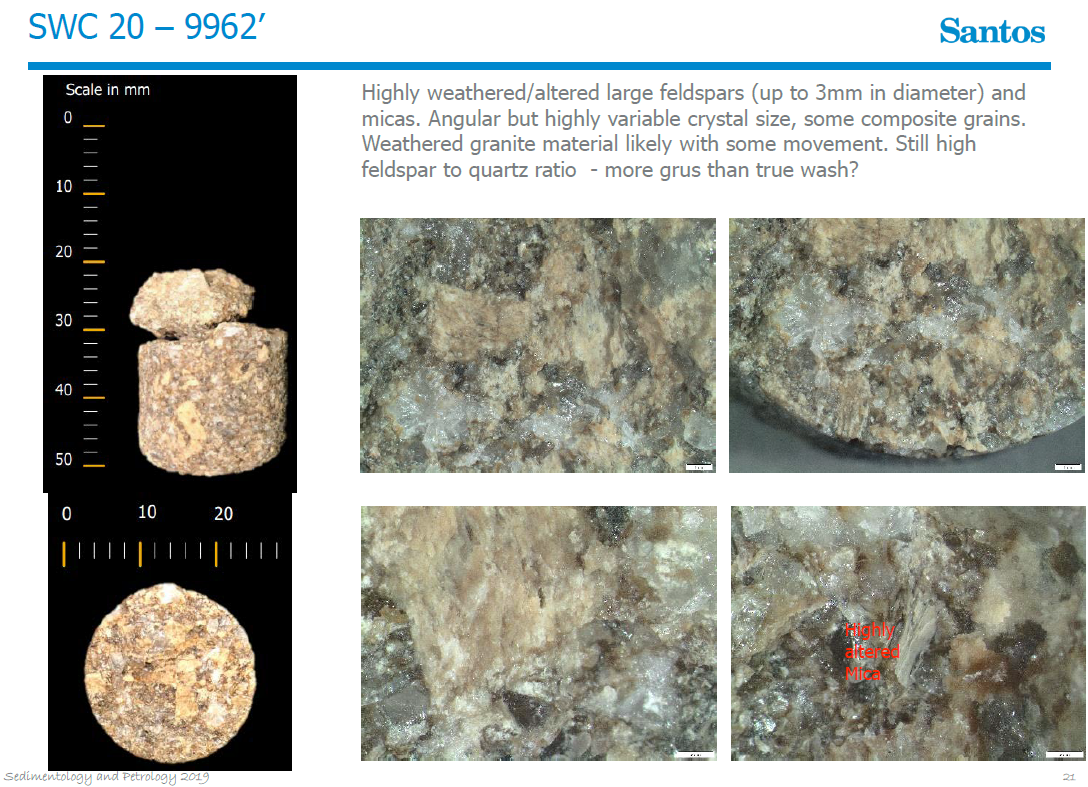
Sidewall core in the Granite Wash in Moomba 230 (from Well Completion Report)


Sidewall core locations of the Granite Wash reservoir and seal in Moomba 230 (excerpt from Composite Log)
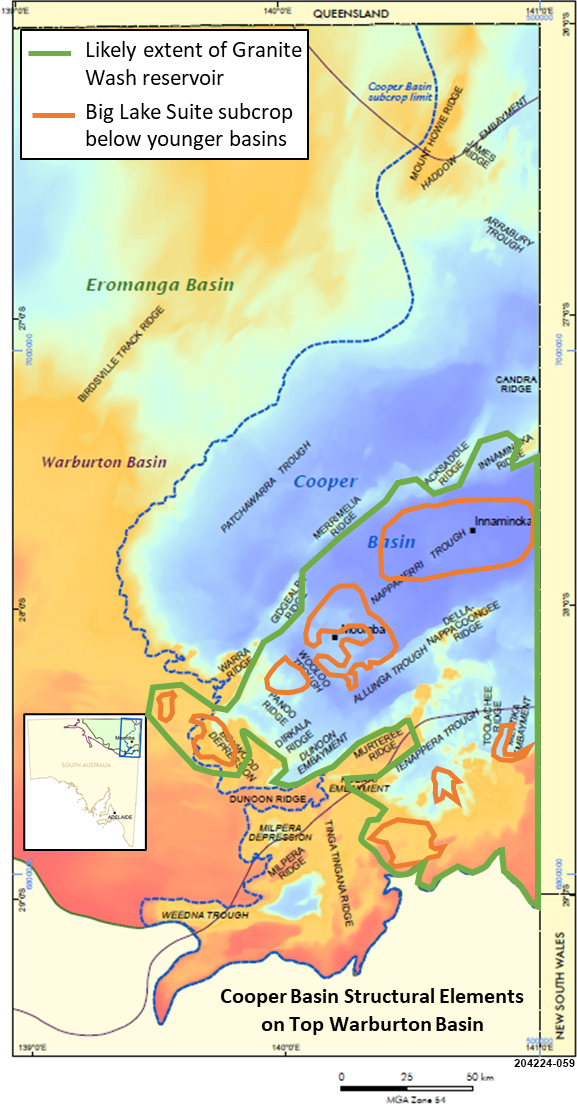
Likely extent of the Granite Wash reservoir
Intraformational shales and coals of the Patchawarra Formation act as suitable seals locally, both within the Lower and the Middle Patchawarra dependent upon timing of erosion of the granite, as shown on the schematic cross-section. The Murteree Shale acts as the regional seal for the Patchawarra Formation.
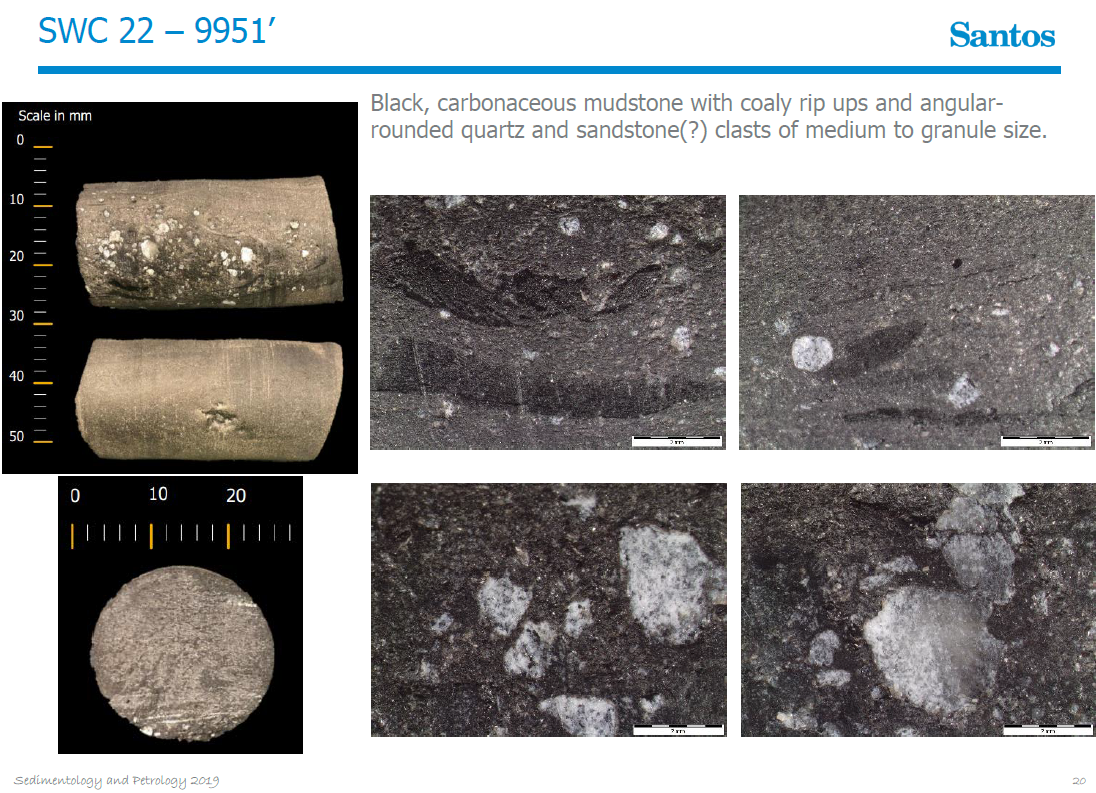
Sidewall core in the Granite Wash in Moomba 230 (from Well Completion Report)


Sidewall core locations of the Granite Wash reservoir and seal in Moomba 230 (excerpt from Composite Log)
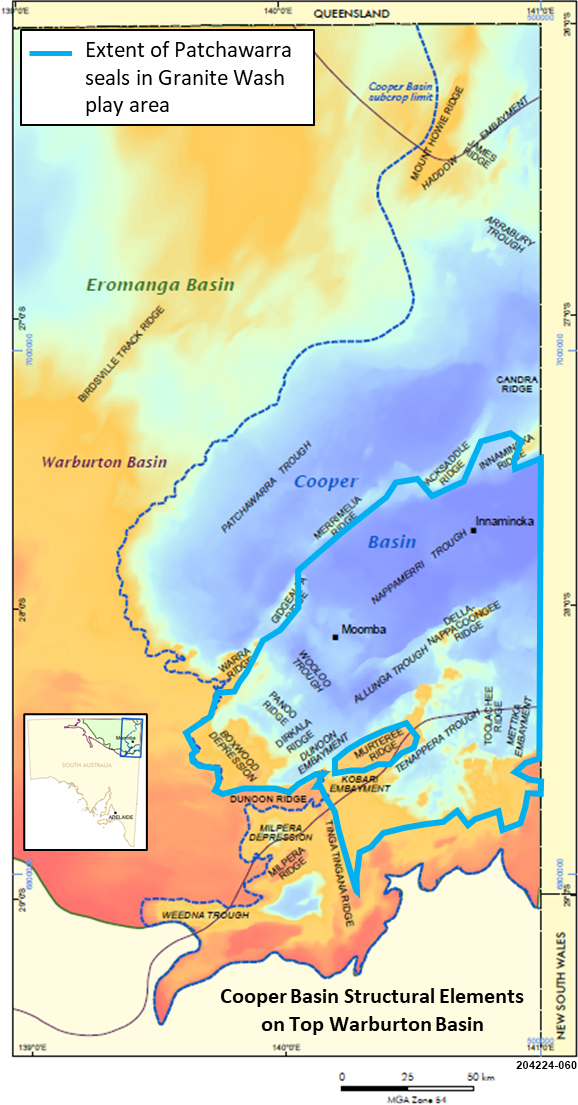
Likely extent of Patchawarra seals in the Granite Wash play area
The coals within the Patchawarra Formation are recognised as one of the main source rocks for gas in the Cooper Basin. In the area around the Granite Wash play the Patchawarra coals are sufficiently deep to be mature enough to have generated significant amounts of gas.
Hydrocarbon generation from the Patchawarra Formation began in the Permian within the deeper parts of the Nappamerri Trough, although in general most hydrocarbons were generated in the mid-Cretaceous (Hall et al, 2016b). Where sufficient untransformed kerogen remains, the Neogene thermal event has resulted in further minor hydrocarbon generation, which continues to the present day.
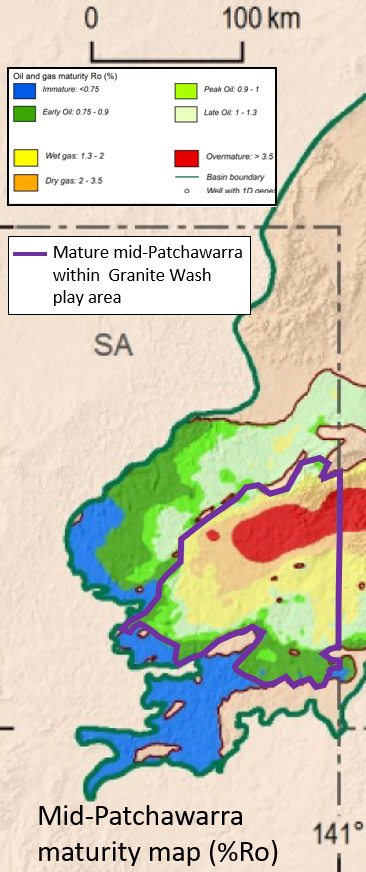
Maturity of the mid-Patchawarra around the Granite Wash play (modified from Hall et al, 2015a)
Hydrocarbon charge of the granite reservoir facies is via face-loading by the onlapping Patchawarra formation, which is confirmed by equivalent gas compositions for the granite wash and Patchawarra Formation reservoirs (Moriarty et al, 2020).
The extent of the charge may be greater than where the mature source rocks occur if they are in communication with carrier beds that act as conduits to the Granite Wash reservoir.
| Structural: | Potential for anticlinal and fault traps Timing of trap formation: Late Permian and Triassic |
|---|---|
| Stratigraphic elements: | (i) Potential for stratigraphic traps dependent upon morphology of the Granite Wash intercalation with Patchawarra Formation Timing of trap formation: During deposition of the Patchawarra Formation |
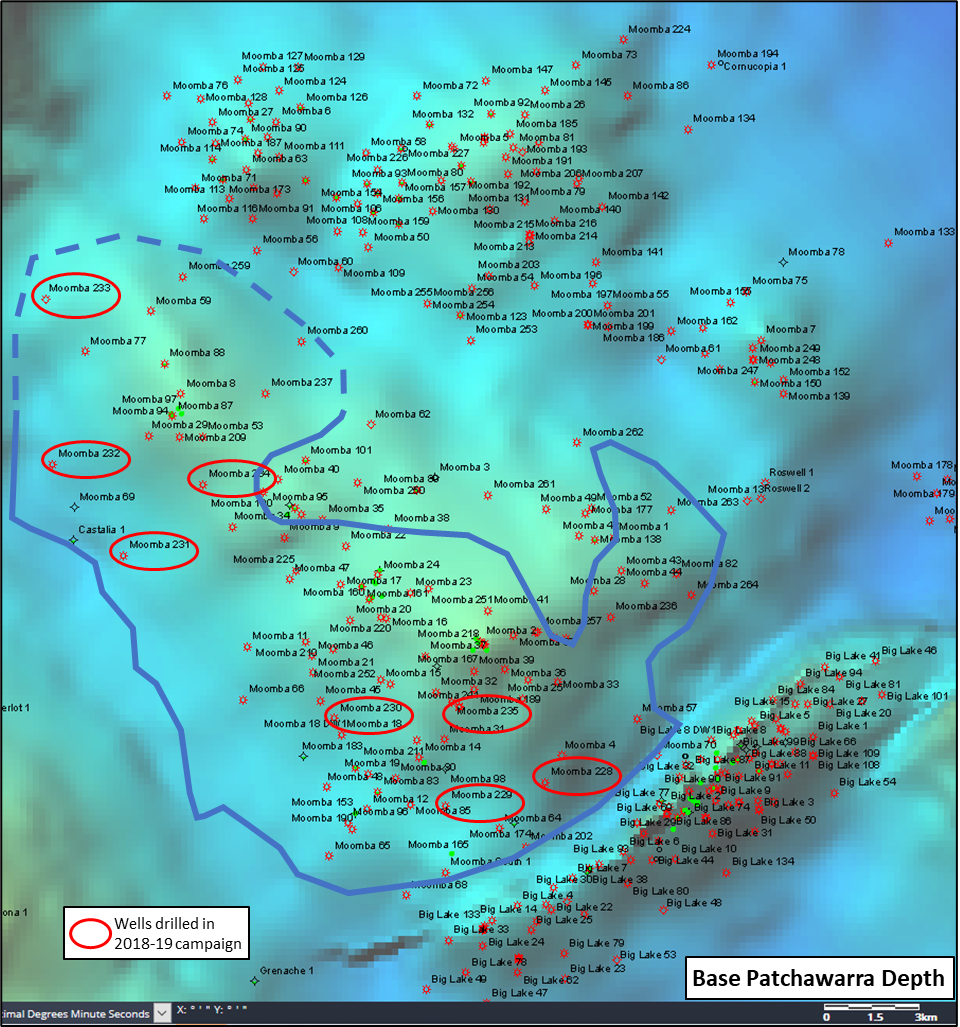
Contingent resource area in Moomba for the Patchawarra Formation and Granite Wash, clearly showing stratigraphic closure (solid area outline from Ovenden, 2019)
The limits of each of the Granite Wash reservoir, Patchawarra seals and the Patchawarra source rocks are combined to produce an extent for the Granite Wash play. The limits to the play maybe more extensive than the limit of the mature source rocks, as hydrocarbon charge may have occurred if the mature source rocks are in communication with carrier beds that act as conduits to the Granite Wash reservoir.
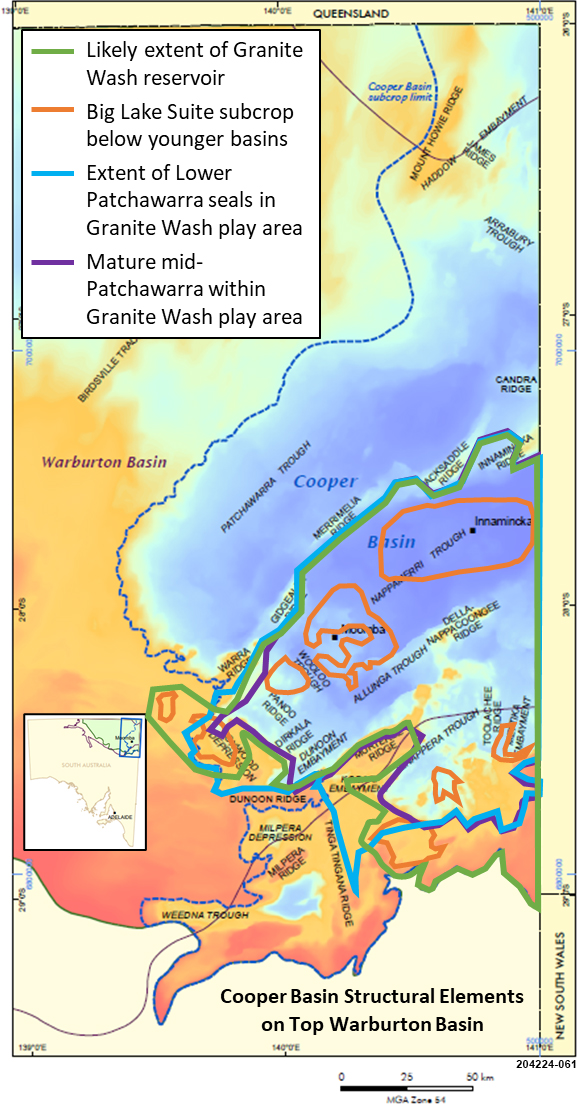

Granite Wash play elements and Granite Wash play extent in the Cooper Basin
| Proven production from the Granite Wash: | Moomba Field |
| Number of wells with production: | 24 |
| Total production at 31 December 2020: | 54.64m3E6 (1.93Bcf) raw gas (PEPS South Australia) |
| Hydrocarbon flow rates: | “Proven sustained flow in multiple tests” (Ovenden, 2019); “commercial flow rates confirmed” (Moriarty et al, 2020). |
See PEPS database for latest production data.
Yet to be determined; >1 Tcfg?.
Borazani, S., Kulikowski, D., Amrouch, K. and Pavel Bedrikovetsky, P., 2019: Composition Changes of Hydrocarbons during Secondary Petroleum Migration (Case Study in Cooper Basin, Australia), Geosciences 2019, 9, 78
Gatehouse, C.G., Fanning, C.M., Flint, R.B., 1995: Geochronology of the Big Lake Suite, Warburton Basin, northeastern South Australia, Geological Survey of South Australia, Quarterly Geological Notes, 128, p8-16.
Hall, L.S., Boreham, C.J., Edwards, D.S., Palu, T.J., Buckler, T., Hill, A.J. & Troup, A. 2016a: Cooper Basin Source Rock Geochemistry: Regional Hydrocarbon Prospectivity of the Cooper Basin, Part 2. Record 2016/06. Geoscience Australia, Canberra.
Hall, L.S., Hill, A., Troup, A., Korsch, R., Radke, B., Nicoll, R.S., Palu, T., Wang, L. & Stacey, A. 2015a: Cooper Basin architecture and lithofacies: regional hydrocarbon prospectivity of the Cooper Basin, Part 1. Record 2015/31. Geoscience Australia, Canberra.
Hall, L.S., Palu, T.J., Murray, A.P., Boreham, C.J., Edwards, D.S., Hill, A.J. & Troup, A. 2016b: Cooper Basin Petroleum Systems Analysis: Regional Hydrocarbon Prospectivity of the Cooper Basin, Part 3. Record 2016/29. Geoscience Australia, Canberra.
Kuske, T.J., Hall, L.S., Hill, A.J., Troup, A.J., Edwards, D.S., Boreham, C.J. & Buckler, T. 2015: Source rocks of the Cooper Basin. Search and Discovery Article #90217, AAPG/SEG International Conference & Exhibition, Melbourne, Australia, September 13-16, 2015.
Lemon, N., pers. comm. 2020; Notes on visit to Challenger to view a recent core through the Moomba Granite (part of the Big Lake Granite Suite); unpublished
Meixner, A.J., Boucher, R.K., Yeates, A.N., Frears, R.A and Gunn, P.J., 1999: Interpretation of Geophysical and Geological Data Sets, Cooper Basin Region, South Australia; AGSO Record 1999/22, Geoscience Australia, Canberra.
Meixner, T. and F. Holgate, 2009: In search of hot buried granites: A 3D map of sub-sediment granitic bodies in the Cooper Basin region of Australia, generated from inversions of gravity data; ASEG Extended Abstracts 2009, 1-11.
Meixner, A.J. & Holgate, F. 2009: The Cooper Basin Region 3D Map Version 1: A Search for Hot Buried Granites. Record 2009/15, Geoscience Australia, Canberra.
Moriarty, H., Clifford, J, Donley, J. and Maxwell, L., 2020: Unlocking material gas resources – Moomba South case study; The APPEA Journal, 60(2), pp 736-741.
Ovenden, W., 2019: Cooper Basin Growth Opportunity; Santos presentation, SA Roundtable, 11 Nov 2019.


